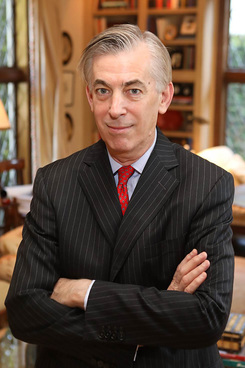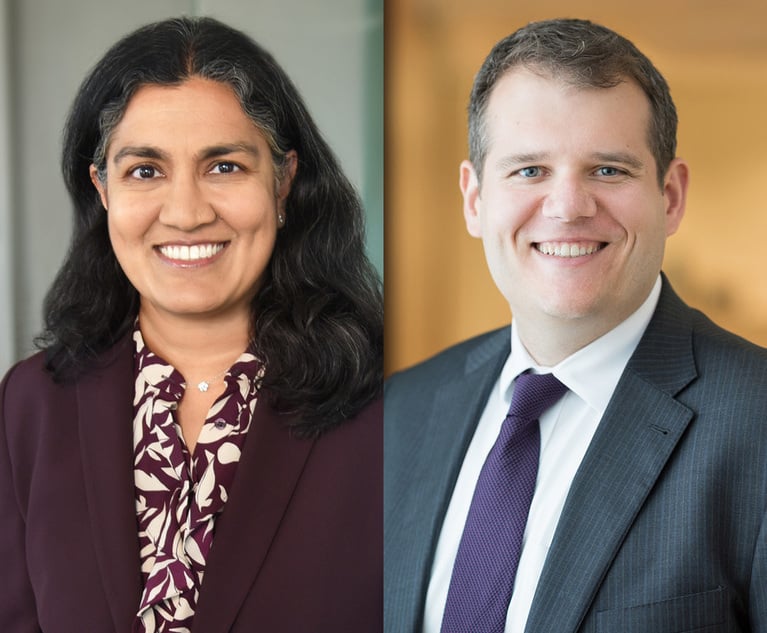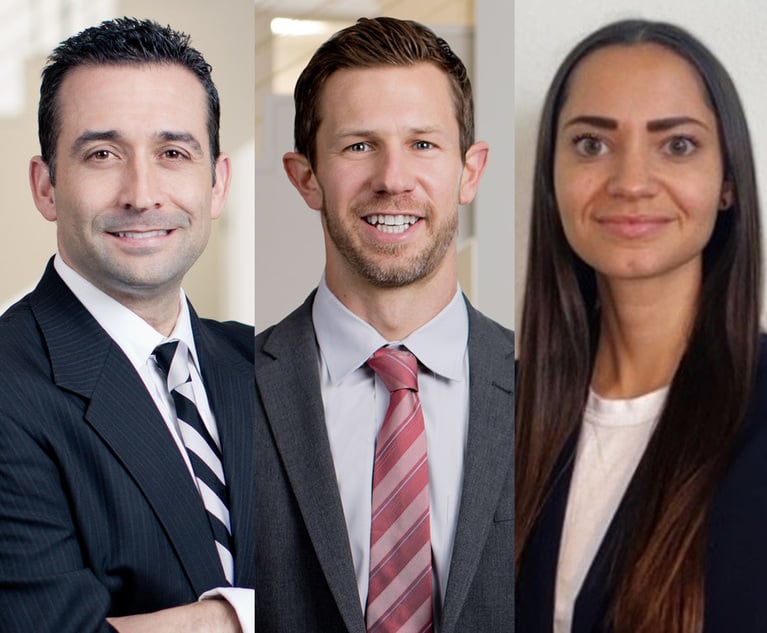Susman Godfrey Focused on Innovation, Efficiency Before They Were 'Buzzwords'
The firm has been competing with larger counterparts in Big Law for over four decades, using its size to its advantage.
June 19, 2018 at 01:47 PM
7 minute read
 Neal Manne of Susman Godfrey.
Neal Manne of Susman Godfrey.
Neal Manne is one of the managing partners at midsize litigation boutique Susman Godfrey. The firm has been competing with larger counterparts in Big Law for over four decades, using its size to its advantage.
Answers have been edited lightly for style.
How big is your firm, where is it located and what are its primary areas of practice and focus?
We have 4 offices: Houston, New York, Los Angeles and Seattle. Our practice is exclusively focused on litigation. Our practice is national: we routinely handle cases in state and federal courts across the entire country. We currently have 132 lawyers, as follows: 65 partners (all of our partners are full equity partners); 43 partnership-track associates; and 32 “other” lawyers consisting of of counsel and staff attorneys who are not on partnership track. Our model of having more partners than associates obviously is very unusual.
Please explain your firm's governance structure and compensation model.
Our firm has two managing partners, of which I am one (founder Steve Susman is the other). We have a 16-person executive committee, which meets weekly. The entire firm (all lawyers) meets each week as well. Other than issues of compensation or partnership, our associates are full voting members in all firm decision-making. At a weekly firm meeting, a brand new associate has the same voting power as me or any other partner.
Associate compensation consists of base salaries that consistently are at or near the top of the market, and year-end merit bonuses that consistently meet or exceed the market.
Partner compensation consists of two components, one relating to fees received by the firm from cases on which a partner has some or all of the case origination credit, and another component based on the work done by the partner on cases for which she or he does not have any origination credit.
What do you view as the two biggest opportunities for your firm, and what are the two biggest threats?
Our biggest opportunities arise from the fact that we are experts at preparing cases for trial and deeply experienced at trying and winning cases of all types; that we have been a leader in alternative fee arrangements for our entire existence as a firm (nearly 40 years—long before AFAs were a buzzword); that we work on both sides of the docket, handling large cases for both plaintiffs and defendants; and that our firm's commitments to genuine democracy, early responsibility, and high associate compensation have continued to attract to our firm the very, very best graduating law students and judicial law clerks.
Our only threat is that our growth over time, even though quite moderate, combined with the eventual retirement of some senior partners, makes it challenging to maintain the unique firm culture and camaraderie. We work hard to preserve it, including multiple retreats each year.
After the recession hit, the prevailing theory was that midsize firms would start to see more work come their way from large clients who could no longer justify paying Big Law rates. What has been your experience?
We were drowning in work before, during and after the recession. Given our longstanding reputation as the very best trial lawyers in the country, our firm remained in very high demand through each phase of the economic cycle.
Are your clients pushing for more alternative fee arrangements, and if so what types? Is your firm amenable to those requests?
Our firm has been the leader in AFAs since our inception nearly 40 years ago. We have always handled much of our practice on the basis of contingent or other alternative fee arrangements. We strongly encourage this with clients. We handle many cases on the basis of flat monthly fees, fully contingent fees, and hybrid arrangements. Less than 20 percent of our revenues comes from hourly billing, and we expect that percentage to continue to decline as more clients—especially those that have been using Big Law firms—see the enormous benefits to them of alternative fee arrangements with firms like ours.
There is much debate around how law firms can foster the next generation of legal talent. What advantages and disadvantages do midsize firms have in attracting and retaining young lawyers, particularly millennials?
I cannot speak for midsize firms generally, but Susman Godfrey has these advantages:
- We give enormous responsibility to our associates very early in their practices, including “stand-up” opportunities in court. About half of our associates go to trial in a given year—and actually participate in the trial.
- We do not have departments or practice groups, so associates are not pigeonholed into one area of litigation practice or working with the same partners over and over.
- We have the flexibility to pursue smaller cases, and pro bono matters.
- We have a docket system designed to ensure that associates get a broad range of opportunities on both plaintiffs and defendants cases.
- We offer lawyers more flexibility to set their own schedules, manage their own tasks, and take a very entrepreneurial approach to our practice, completely unlike Big Law firms.
Does your firm employ any nonlawyer professionals in high-level positions (e.g. COO, business development officer, chief strategy officer, etc.)? If so, why is it advantageous to have a nonlawyer in that role? If not, have you considered hiring any?
We always have had a nonlawyer executive director. Our current executive director, Nikki Thornton, does an excellent job of running the nonlegal side of our business, and is highly regarded by all our lawyers and staff.
What if any technology advancements have you made in your firm in recent years? What are the challenges in implementing tech changes?
We have significantly increased our focus on security and internal security training, working closely with some of our larger clients who have sophisticated security protocols.
What would you say is the most innovative thing your firm has done recently, whether it be internal operations, how you work with clients, etc.?
Our greatest innovation remains in the area of fee arrangements. We are endlessly creative in coming up with non-hourly fee proposals to suit a potential client's needs, and to align our interests more closely with theirs. We are relentless in our efforts to ensure that our firm continues to win accolades, as it recently did, for being the best trial firm in America.
Does your firm have a succession plan in place? If so, what challenges do you face in trying to execute that plan? If you don't currently have a plan, is it an issue your firm is thinking about?
We adopted a succession plan several years ago, before the retirement of our other name partner Lee Godfrey. We had a very smooth transition when Godfrey retired in 2014, and expect to have a smooth transition when our founding partner, Steve Susman, retires in approximately 2037!
This content has been archived. It is available through our partners, LexisNexis® and Bloomberg Law.
To view this content, please continue to their sites.
Not a Lexis Subscriber?
Subscribe Now
Not a Bloomberg Law Subscriber?
Subscribe Now
NOT FOR REPRINT
© 2025 ALM Global, LLC, All Rights Reserved. Request academic re-use from www.copyright.com. All other uses, submit a request to [email protected]. For more information visit Asset & Logo Licensing.
You Might Like
View All
US Patent Innovators Can Look to International Trade Commission Enforcement for Protection, IP Lawyers Say

How Uncertainty in College Athletics Compensation Could Drive Lawsuits in 2025

Vinson & Elkins' Veteran Pro Bono Counsel on How Needs Could Change After the Election
7 minute read
Campaign for Judge: 2 San Antonio Justices Compete for Same Seat in Election
7 minute readTrending Stories
- 1Am Law 200 Firms Announce Wave of D.C. Hires in White-Collar, Antitrust, Litigation Practices
- 2K&L Gates Files String of Suits Against Electronics Manufacturer's Competitors, Brightness Misrepresentations
- 3'Better of the Split': District Judge Weighs Circuit Divide in Considering Who Pays Decades-Old Medical Bill
- 4Which Georgia Courts Are Closed Today?—Here's a List
- 5After DEI Rollbacks, Employment Lawyers See Potential For Targeting Corporate Commitment to Equality
Who Got The Work
J. Brugh Lower of Gibbons has entered an appearance for industrial equipment supplier Devco Corporation in a pending trademark infringement lawsuit. The suit, accusing the defendant of selling knock-off Graco products, was filed Dec. 18 in New Jersey District Court by Rivkin Radler on behalf of Graco Inc. and Graco Minnesota. The case, assigned to U.S. District Judge Zahid N. Quraishi, is 3:24-cv-11294, Graco Inc. et al v. Devco Corporation.
Who Got The Work
Rebecca Maller-Stein and Kent A. Yalowitz of Arnold & Porter Kaye Scholer have entered their appearances for Hanaco Venture Capital and its executives, Lior Prosor and David Frankel, in a pending securities lawsuit. The action, filed on Dec. 24 in New York Southern District Court by Zell, Aron & Co. on behalf of Goldeneye Advisors, accuses the defendants of negligently and fraudulently managing the plaintiff's $1 million investment. The case, assigned to U.S. District Judge Vernon S. Broderick, is 1:24-cv-09918, Goldeneye Advisors, LLC v. Hanaco Venture Capital, Ltd. et al.
Who Got The Work
Attorneys from A&O Shearman has stepped in as defense counsel for Toronto-Dominion Bank and other defendants in a pending securities class action. The suit, filed Dec. 11 in New York Southern District Court by Bleichmar Fonti & Auld, accuses the defendants of concealing the bank's 'pervasive' deficiencies in regards to its compliance with the Bank Secrecy Act and the quality of its anti-money laundering controls. The case, assigned to U.S. District Judge Arun Subramanian, is 1:24-cv-09445, Gonzalez v. The Toronto-Dominion Bank et al.
Who Got The Work
Crown Castle International, a Pennsylvania company providing shared communications infrastructure, has turned to Luke D. Wolf of Gordon Rees Scully Mansukhani to fend off a pending breach-of-contract lawsuit. The court action, filed Nov. 25 in Michigan Eastern District Court by Hooper Hathaway PC on behalf of The Town Residences LLC, accuses Crown Castle of failing to transfer approximately $30,000 in utility payments from T-Mobile in breach of a roof-top lease and assignment agreement. The case, assigned to U.S. District Judge Susan K. Declercq, is 2:24-cv-13131, The Town Residences LLC v. T-Mobile US, Inc. et al.
Who Got The Work
Wilfred P. Coronato and Daniel M. Schwartz of McCarter & English have stepped in as defense counsel to Electrolux Home Products Inc. in a pending product liability lawsuit. The court action, filed Nov. 26 in New York Eastern District Court by Poulos Lopiccolo PC and Nagel Rice LLP on behalf of David Stern, alleges that the defendant's refrigerators’ drawers and shelving repeatedly break and fall apart within months after purchase. The case, assigned to U.S. District Judge Joan M. Azrack, is 2:24-cv-08204, Stern v. Electrolux Home Products, Inc.
Featured Firms
Law Offices of Gary Martin Hays & Associates, P.C.
(470) 294-1674
Law Offices of Mark E. Salomone
(857) 444-6468
Smith & Hassler
(713) 739-1250






